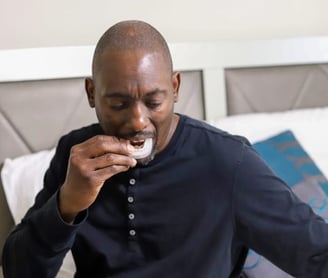Oral Appliance
Oral appliances, or mandibular advancement devices, are custom fabricated dental devices. They work by increasing the space in the back of the throat by moving the jaw forward changing the position of the tongue. While CPAP can be more effective than oral appliances, oral appliances are easier to use, and therefore in some patients, they may be used for more total hours per night—providing better control of apneas.
These devices are customized for each individual by a qualified dentist. If this therapy is a good option for you, your doctor will refer you to a qualified dentist.


Pros
Appliances are easy to wear and comfortable to use.
Appliances are small, noiseless and barely noticeable.
Appliances are convenient to travel with.
Appliances don’t bother bed partners.
Appliances reduce self-consciousness that many report feeling with CPAP use.
Appliances are not permanent, use can be discontinued anytime.
Cons
Severe OSA patients must have tried and failed on CPAP first.
Requires 1-2 minute daily jaw exercises.
May cause discomfort or pain in the jaw, especially in the beginning.


Patient Satisfaction
Oral appliance therapy (OAT) is very effective in treating patients with sleep-disordered breathing, with a compliance rate shown to be as high as 90% over a 2.5-year period.1
OAT is associated with greater patient satisfaction than nasal continuous positive airway pressure (CPAP) therapy.2
In a randomized crossover trial comparing OAT to CPAP in patients with obstructive sleep apnea, about 81% preferred OAT.3
Improved Health
Among patients with obstructive sleep apnea, both continuous positive airway pressure (CPAP) and mandibular advancement devices (MADs) were associated with reductions in blood pressure. Network meta-analysis did not identify a statistically significant difference between the blood pressure outcomes associated with these therapies.4
A mandibular advancement device for obstructive sleep apnea reduces nocturnal blood pressure in women.5
1. Yoshida K. Effects of a mandibular advancement device for the treatment of sleep apnea syndrome and snoring on respiratory function and sleep quality. Cranio. 2000 Apr;18(2):98-105.
2. Ferguson KA, Ono T, Lowe AA, Keenan SP, Fleetham JA. A randomized crossover study of an oral appliance vs. nasal-continuous positive airway pressure in the treatment of mild-moderate obstructive sleep apnea. Chest. 1996 May;109(5):1269-75.
3. Tan YK, L’Estrange PR, Luo YM, Smith C, Grant HR, Simonds AK, Spiro SG, Battagel JM. Mandibular advancement splints and continuous positive airway pressure in patients with obstructive sleep apnoea: a randomized cross-over trial. Eur J Orthod. 2002 Jun;24(3):239-49.
4. Bratton DJ, Gaisl T, Wons AM, Kohler M. CPAP vs. mandibular advancement devices and blood pressure in patients with obstructive sleep apnea: a systematic review and meta-analysis. JAMA. 2015 Dec 1;314(21):2280-93.
5. Rietz H, Franklin KA, Carlberg B, Sahlin C, Marklund M. Nocturnal blood pressure is reduced by a mandibular advancement device for sleep apnea in women: findings from secondary analyses of a randomized trial. J Am Heart Assoc. 2018 Jun 21;7(13).
DISCLAIMER: THIS WEBSITE DOES NOT PROVIDE MEDICAL ADVICE
The information, including but not limited to, text, graphics, images and other material contained on this website are intended for educational purposes only.
No content or material on this site is intended to be a substitute for professional medical advice, diagnosis or treatment. Always seek the advice of your healthcare provider with any questions you may have regarding your medical condition.
Reliance on any information provided on this website is solely at your own risk.